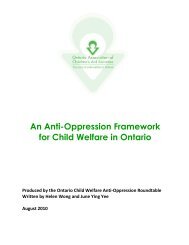English - Ontario Association of Children's Aid Societies
English - Ontario Association of Children's Aid Societies
English - Ontario Association of Children's Aid Societies
You also want an ePaper? Increase the reach of your titles
YUMPU automatically turns print PDFs into web optimized ePapers that Google loves.
Genetic tendencies, religion, culture, and geographic region,<br />
together with all the experiences people have both internally<br />
and in relationship to their environments, give rise to their<br />
worldview, or their general way <strong>of</strong> viewing themselves and the<br />
world around them (Miller, Schlitz & Vieten, 2010).<br />
This Practice Guide is based on five working assumptions:<br />
1. Child welfare pr<strong>of</strong>essionals are engaged in their work<br />
using a specific worldview whether the worker is non-<br />
Aboriginal or a First Nations, Métis or Inuit person.<br />
No matter what our colour, religion, social status or racial<br />
origins may be, those <strong>of</strong> us who have grown up within a North<br />
American or European school system, playing with other<br />
children, watching television, reading newspapers and books,<br />
going to college and eventually entering the work force have<br />
learned to participate in a worldview that is common to the<br />
Western industrial nations (Peat, 2002).<br />
2. The dominant Western worldview is not consistent<br />
with an Indigenous worldview. An Indigenous worldview<br />
is based on traditional culture and knowledge<br />
and ways <strong>of</strong> knowing.<br />
An Indigenous perspective is a spiritually based<br />
humanitarian and environmental perspective. Our<br />
worldview is full <strong>of</strong> teachings <strong>of</strong> responsibility, much deeper<br />
than any responsibility to self, but a responsibility to each<br />
other extending beyond, to all <strong>of</strong> life. The feeling is best<br />
portrayed as love (sic) and when it is taken away, a hole, a<br />
void in the chest is left (Shane Tabobondung, Chief <strong>of</strong><br />
Wasauksing First Nation).<br />
The lens <strong>of</strong> CAS is very mainstream/Western model — this is<br />
why CAS does not ‘see’ our stories when we are telling them.<br />
Their worldview is completely different than our own as<br />
Aboriginal people (Focus group participant).<br />
3. The Western worldview considers knowledge to be<br />
something that can be acquired and accumulated.<br />
Based on that belief, this Practice Guide was developed<br />
with the intent that it would be read by child welfare<br />
pr<strong>of</strong>essionals and used for CAS training. Peat (2002),<br />
however, wrote that “within the Indigenous world the<br />
act <strong>of</strong> coming to know something involves a personal<br />
transformation.” Using an Indigenous worldview, this<br />
Practice Guide cannot merely be read but must be<br />
accompanied with Indigenous based training.<br />
There are approximately (sic) three<br />
times more Aboriginal children in care<br />
in Canada than at the height <strong>of</strong> the<br />
residential school system in the 1940s.<br />
While Aboriginal children represent<br />
only five percent <strong>of</strong> the children in<br />
Canada, they constitute about 40<br />
percent <strong>of</strong> the children in care in this<br />
country. The incapacities created<br />
within First Nations, Inuit and Métis<br />
communities by the Indian Residential<br />
Schools policy, and other colonial<br />
practices, have led to the current<br />
reality. It is time that those <strong>of</strong> us in child<br />
welfare acknowledge the<br />
uncomfortable truth that,<br />
notwithstanding the existence <strong>of</strong><br />
legislative prescriptions in <strong>Ontario</strong><br />
since at least 1984, we have essentially<br />
continued to play the same role as<br />
did the residential schools; that is to<br />
remove First Nations, Inuit and Métis<br />
children from their families and<br />
communities. And in many cases, again<br />
notwithstanding those prescriptions<br />
to the contrary, we are still not giving<br />
them back. - Engelking, 2009<br />
Special Note: The experience <strong>of</strong><br />
Northern fly-in First Nation<br />
communities will not be fully<br />
represented in the Practice Guide.<br />
These unique communities are not<br />
easily supported by a southern-based<br />
collaborative service model because<br />
many <strong>of</strong> the services are not in<br />
northern communities. Northern<br />
communities have created innovative<br />
ways to respond to family violence that<br />
includes services and helpers in the<br />
community.<br />
11

















